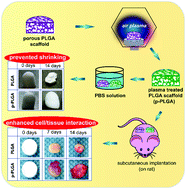Surface modification of porous PLGA scaffolds with plasma for preventing dimensional shrinkage and promoting scaffold–cell/tissue interactions†
Abstract
Due to numerous merits, polyesters have been widely used for the preparation of porous scaffolds for biomedical applications. However, insufficient dimensional stability and weak cell interaction are two critical challenges to highly porous polyester scaffolds fulfilling their roles during applications. Here, we report the surface modification of PLGA scaffolds with air plasma for simultaneously tackling the dimensional shrinkage of PLGA scaffolds and improving scaffold–tissue integration. Highly porous PLGA scaffolds with interconnected pore structures and well orientated microtubules were prepared through lyophilization, and an air plasma process with varied duration was applied to the porous scaffolds. Water contact angle measurements indicated that moderate treatment (120 seconds) can significantly increase the wettability without distorting the morphology of and damaging the PLGA scaffolds. Further characterization (SEM, XPS, μ-CT, and theoretical computations) revealed that the plasma treatment enabled the generation of carboxyl groups on the surface of the PLGA scaffold, and the hydrophilic PLGA chain tends to extend under aqueous conditions in comparison to the hydrophobic pristine PLGA chain. Consequently, this could eliminate the hydrophobic-scaffold/water interface and weaken the driving force behind the distortion of the scaffolds in aqueous conditions, and finally inhibit overall shrinkage and maintain the microstructures of the porous scaffolds. Similar results were observed with porous PLA scaffolds, indicating the generality of air plasma treatment in inhibiting the shrinkage of polyester scaffolds. In the meantime, in vitro cell attachment experiments and in vivo subcutaneous implantation results consistently indicated that better maintaining the microstructure could significantly enhance the short-term cell attachment/proliferation on the scaffold and the long-term scaffold–tissue integration. These findings may inspire many creative and efficient strategies for the surface modification of polyester scaffolds to improve their performance for biomedical applications.



 Please wait while we load your content...
Please wait while we load your content...